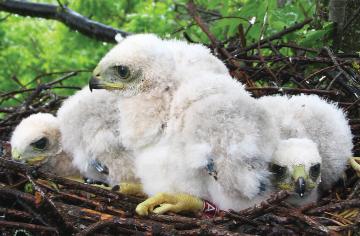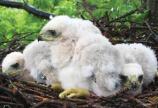Hawks’ nest part of living laboratory

They may not know it, but four Cooper’s hawk chicks and their nest near the Cunningham Building are part of a long-term regional study. Former Ministry of Environment wildlife biologist Andy Stewart has been banding Cooper’s hawk chicks at and around UVic for the past 14 years. Some years he finds up to five nests on campus, but this year counted only one.
“The study has shown that Cooper’s hawks actually thrive in an urban setting and in areas of fragmented forest,” he says. “More than half their prey is introduced species such as European starlings, house sparrows and rats.”
Banding the birds when they are about two weeks old allows biologists to identify and track them over time. The chicks stay in the nest for about a month before fledging, and remain near the nest for another month.
Now retired from his government position, Stewart carries on the project on his own time and with minimal funding. “I’m now dealing with the great-grandchildren of some birds—I can sometimes trace individuals through four or five generations,” he notes.
Although Stewart usually works alone or with his wife Irene, summer students in biology professor Neville Winchester’s third-year vertebrates of BC class have sometimes assisted in the early morning banding of campus hawks. Over the years, Winchester has also used the data from Stewart’s study in his courses.
To find out more about the project, read the article or contact Andy Stewart at andy.stewart@shaw.ca.

